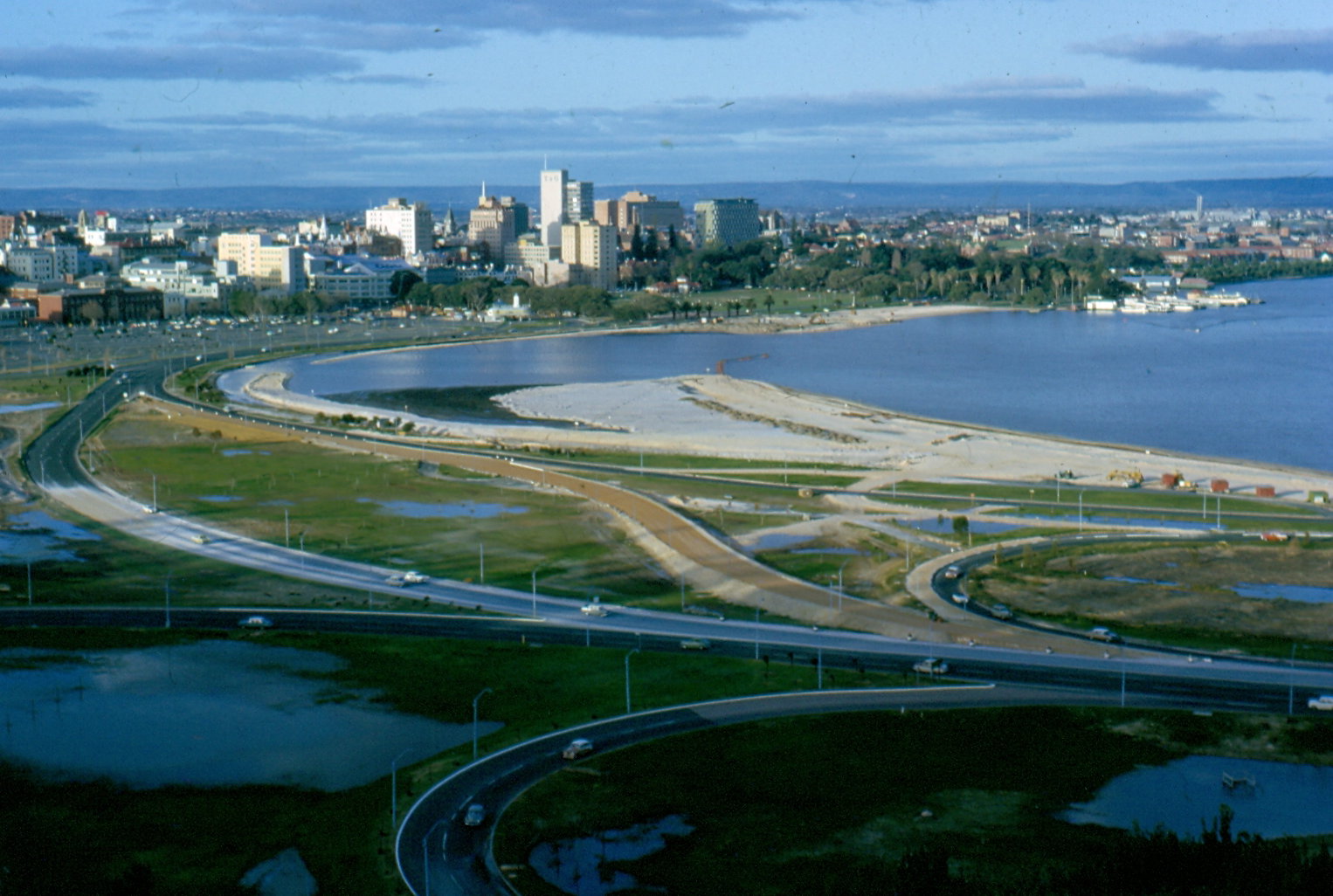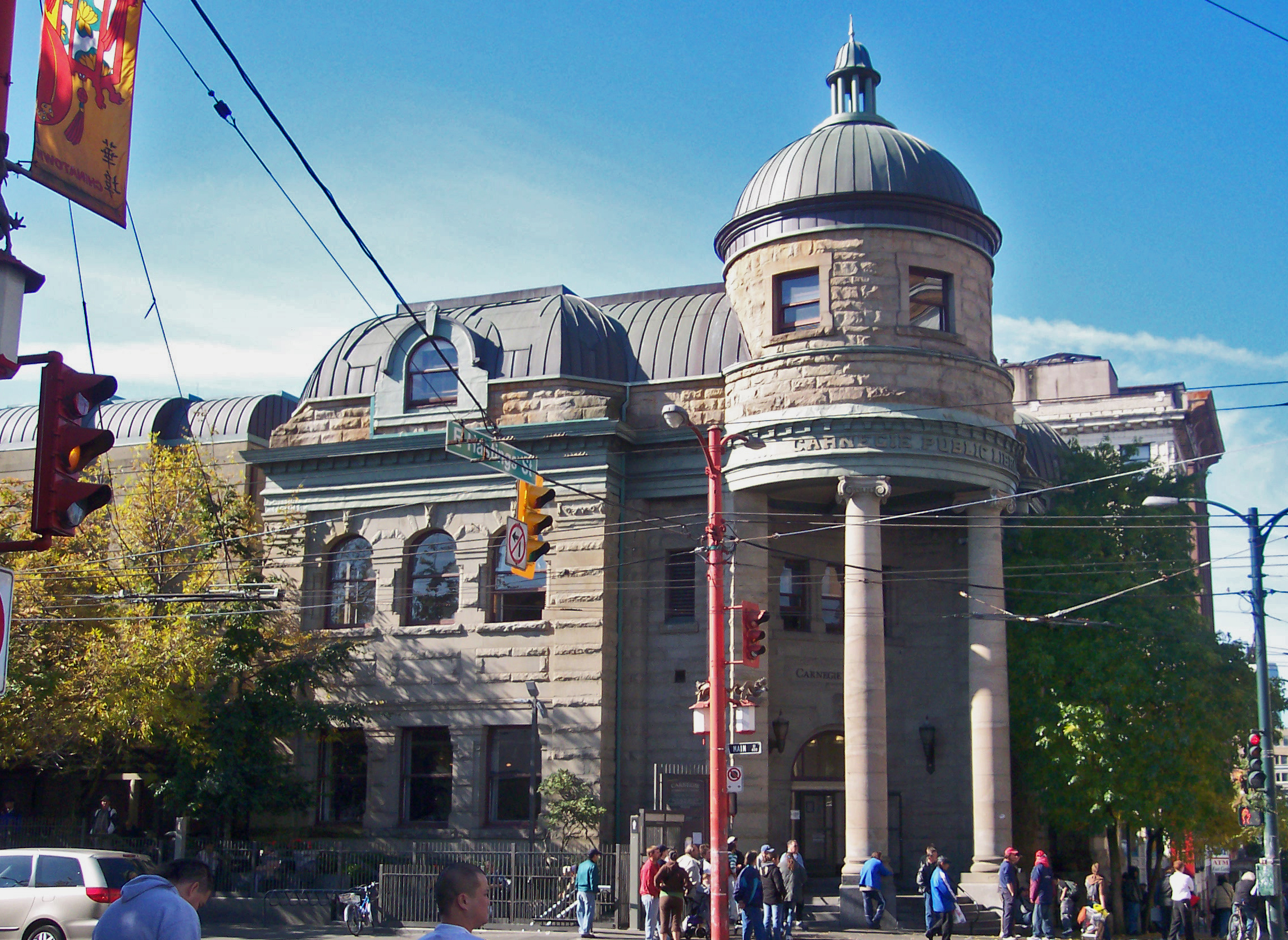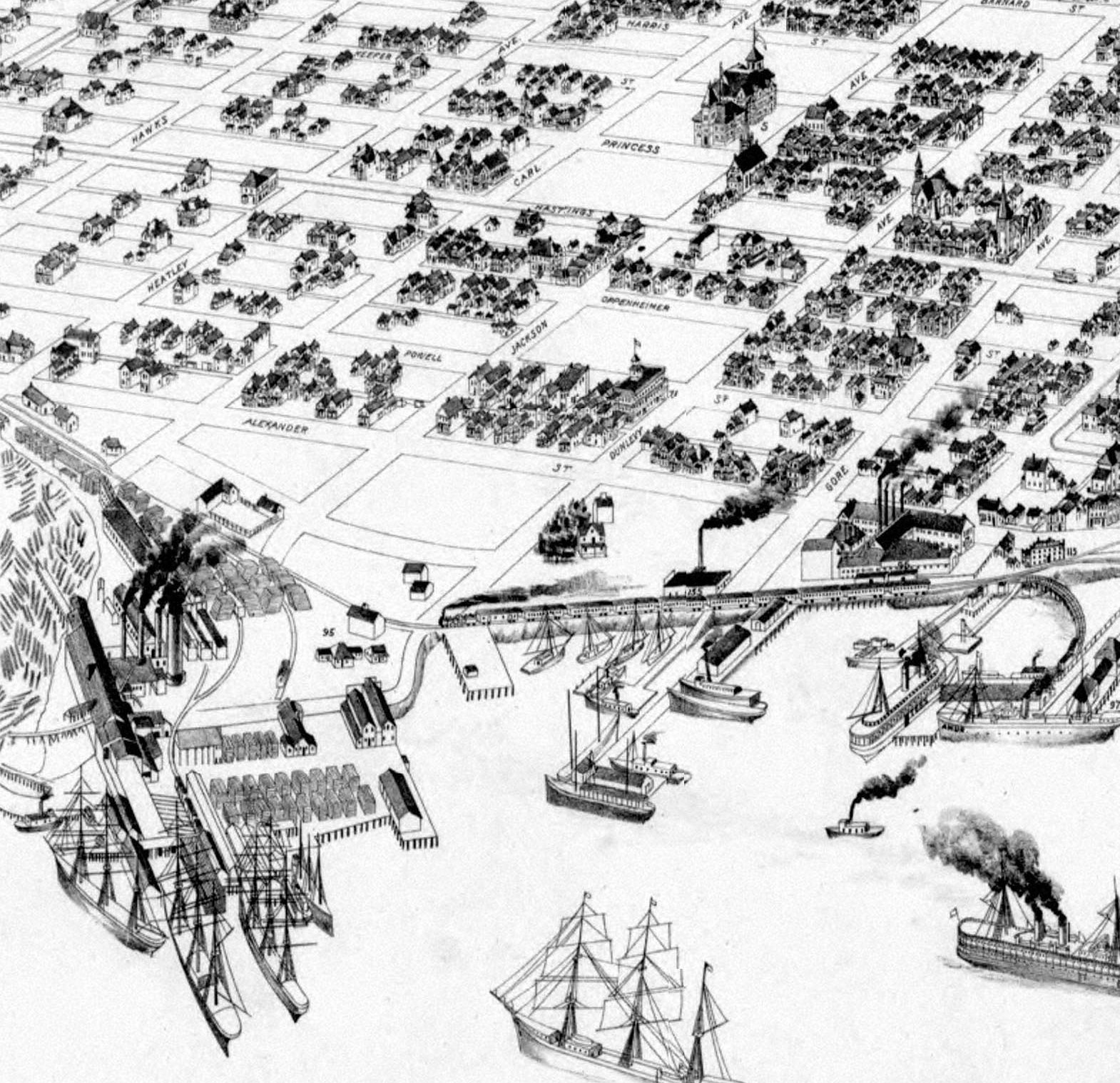|
Main Street, Vancouver
Main Street is a major north–south thoroughfare bisecting Vancouver, British Columbia, Canada. It runs from Waterfront Road by Burrard Inlet in the north, to Kent Avenue alongside the north arm of the Fraser River in the south. Route Beginning by the Port of Vancouver terminals near the nexus of the city's historic Downtown Eastside and Gastown districts, the street runs south through Chinatown south of Hastings Street and continues past the Pacific Central railway station and the Main Street–Science World SkyTrain station. At Terminal Avenue, it slopes up into the Mount Pleasant neighbourhood, which mixes commerce, light industry, brewing, and high-density residential areas. The residential/commercial mix continues south of Broadway, with a high density of restaurants and fashion retailing. This neighbourhood was once blue-collar but is growing distinctly upscale. Between 33rd Avenue and 41st Avenue, the street becomes decidedly more residential as it reaches its t ... [...More Info...] [...Related Items...] OR: [Wikipedia] [Google] [Baidu] |
Vancouver
Vancouver is a major city in Western Canada, located in the Lower Mainland region of British Columbia. As the List of cities in British Columbia, most populous city in the province, the 2021 Canadian census recorded 662,248 people in the city, up from 631,486 in 2016. The Metro Vancouver area had a population of 2.6million in 2021, making it the List of census metropolitan areas and agglomerations in Canada#List, third-largest metropolitan area in Canada. Greater Vancouver, along with the Fraser Valley, comprises the Lower Mainland with a regional population of over 3million. Vancouver has the highest population density in Canada, with over , and the fourth highest in North America (after New York City, San Francisco, and Mexico City). Vancouver is one of the most Ethnic origins of people in Canada, ethnically and Languages of Canada, linguistically diverse cities in Canada: 49.3 percent of its residents are not native English speakers, 47.8 percent are native speakers of nei ... [...More Info...] [...Related Items...] OR: [Wikipedia] [Google] [Baidu] |
SkyTrain (Vancouver)
SkyTrain is the Medium-capacity rail system, medium-capacity rapid transit system serving the Metro Vancouver Regional District, Metro Vancouver region in British Columbia, Canada. SkyTrain has of track and uses Automated guideway transit, fully automated trains on grade-separated tracks running on underground and elevated guideways, allowing SkyTrain to hold consistently high on-time reliability. In , the system had a ridership of , or about per weekday as of . The name "SkyTrain" was coined for the system during Expo 86 because the first line (Expo) principally runs on elevated guideway outside of Downtown Vancouver, providing panoramic views of the metropolitan area. SkyTrain uses the world's third-longest cable-supported transit-only bridge, known as Skybridge (TransLink), SkyBridge, to cross the Fraser River. With the opening of the Evergreen Extension on December 2, 2016, SkyTrain became the longest Rapid transit, rapid transit system in Canada and the longest fully aut ... [...More Info...] [...Related Items...] OR: [Wikipedia] [Google] [Baidu] |
Mount Pleasant, Vancouver
Mount Pleasant is a neighbourhood in the city of Vancouver, British Columbia, Canada, stretching from Cambie Street to Clark Drive and from Great Northern Way and 2nd, to 16th and Kingsway. The neighbourhood, once characterized as working-class, has undergone a process of gentrification since the early 1990s, including the area around the Main Street and Broadway intersection. The neighbourhood is served by the Canada Line, an extension of SkyTrain from Downtown Vancouver to Vancouver International Airport. It is home to a number of artists and writers, including CBC personalities Ian Hanomansing and Tod Maffin, The Tyee editor David Beers and documentary filmmaker Peter W. Klein. History Mount Pleasant owes much of its origins to a former stream. The stream attracted a number of breweries from 1888 to 1912, hence it became known as Brewery Creek. In 1890, the first street cars arrived; as far south as 1st and Main. Brewery Creek, in conjunction with the connecting rou ... [...More Info...] [...Related Items...] OR: [Wikipedia] [Google] [Baidu] |
Strathcona, Vancouver
Strathcona is the oldest residential neighbourhood of Vancouver, British Columbia, Canada. Officially a part of the East Side, it is bordered by Downtown Vancouver's Chinatown neighbourhood and the False Creek inlet (across Main Street) to the west, Downtown Eastside (across Hastings Street) to the north, Grandview-Woodland (across Clark Drive) to the east, and Mount Pleasant to the south of Emily Carr University and the Canadian National Railway and Great Northern Railway (now BNSF Railway) classification yards. By some definitions, Strathcona's northern border is the roads just south of Burrard Inlet, and much of the Downtown Eastside lies within Strathcona. By other definitions, Strathcona's northern boundary is just south of Hastings Street, and the Downtown Eastside is a separate neighbourhood to the north and northwest of Strathcona. Strathcona has long been a hub of immigration and culture relative to Vancouver's more recently settled neighbourhoods. Chinese imm ... [...More Info...] [...Related Items...] OR: [Wikipedia] [Google] [Baidu] |
Japantown, Vancouver
Japantown, Little Tokyo report prepared for the City of Vancouver by Birmingham & Wood et al., pp. 21, 28] or is an old neighbourhood in , British Columbia, Canada, located east of Gastown and north of , that once had a concentration of Japanese immigrants. Japantown ... [...More Info...] [...Related Items...] OR: [Wikipedia] [Google] [Baidu] |
Land Reclamation
Land reclamation, often known as reclamation, and also known as land fill (not to be confused with a waste landfill), is the process of creating new Terrestrial ecoregion, land from oceans, list of seas, seas, Stream bed, riverbeds or lake beds. The land reclaimed is known as reclamation ground, reclaimed land, or land fill. History In ancient Egypt, the rulers of the Twelfth Dynasty of Egypt, Twelfth Dynasty (c. 2000–1800 BC) undertook a far-sighted land reclamation scheme to increase agricultural output. They constructed levees and canals to connect the Faiyum Oasis, Faiyum with the Bahr Yussef waterway, diverting water that would have flowed into Lake Moeris and causing gradual evaporation around the lake's edges, creating new farmland from the reclaimed land. A similar land reclamation system using dams and drainage canals was used in the Greek Lake Copais, Copaic Basin during the Middle Helladic period, Middle Helladic Period (c. 1900–1600 BC). Another early large-s ... [...More Info...] [...Related Items...] OR: [Wikipedia] [Google] [Baidu] |
Bascule Bridge
A bascule bridge (also referred to as a drawbridge or a lifting bridge) is a moveable bridge with a counterweight that continuously balances a span, or leaf, throughout its upward swing to provide clearance for boat traffic. It may be single- or double-leafed. The name comes from the French term for balance scale, which employs the same principle. Bascule bridges are the most common type of movable span because they open quickly and require relatively little energy to operate, while providing the possibility for unlimited vertical clearance for marine traffic. History Bascule bridges have been in use since ancient times, but until the adoption of steam power in the 1850s, very long, heavy spans could not be moved quickly enough for practical application. Types There are three types of bascule bridge and the counterweights to the span may be located above or below the bridge deck. The fixed-trunnion (sometimes a "Chicago" bascule) rotates around a large axle that raises ... [...More Info...] [...Related Items...] OR: [Wikipedia] [Google] [Baidu] |
False Creek
False Creek () is a short narrow inlet in the heart of Vancouver, separating the Downtown Vancouver, Downtown and West End, Vancouver, West End list of neighbourhoods in Vancouver, neighbourhoods from the rest of the city. It is one of the four main bodies of water bordering Vancouver, along with English Bay (Vancouver), English Bay (of which it is an inland extension), Burrard Inlet, and the Fraser River. Granville Island is located within the inlet. George Henry Richards named False Creek during his hydrographic survey of 1856–1863. While travelling along the south side of the Burrard Inlet, Richards thought he was traversing a Stream, creek; upon discovering his error, he gave the inlet its current name. The inlet opens into the English Bay (Vancouver), English Bay to its northwest, and is surrounded by the Downtown and West End neighbourhoods in the north, Strathcona, Vancouver, Strathcona in the east, and Mount Pleasant, Vancouver, Mount Pleasant, Fairview, Vancouver, Fa ... [...More Info...] [...Related Items...] OR: [Wikipedia] [Google] [Baidu] |
Carnegie Centre
Carnegie Community Centre is located at 401 Main Street at the corner of Hastings Street, in the old Carnegie Public Library building in the Downtown Eastside of Vancouver, British Columbia. In 1901 Vancouver requested $50,000 from industrialist and philanthropist Andrew Carnegie for the purpose of building a library. Carnegie agreed, provided the City of Vancouver supplied the site and contributed $5000 a year. The original public library was completed in 1903. For decades, the top floor was the home of the Vancouver Museum. The Vancouver Public Library moved into a more spacious building at 750 Burrard Street in 1957 and the Carnegie building eventually fell into disrepair. Neighbourhood poverty activists from the Downtown Eastside Residents' Association convinced city council to turn it into a public space for local residents, and it opened as the Carnegie Community Centre in the 1980s. It now houses recreation facilities, a low-cost cafeteria, a branch of the Vancouver Publi ... [...More Info...] [...Related Items...] OR: [Wikipedia] [Google] [Baidu] |
Downtown Vancouver
Downtown Vancouver is the central business district and the city centre list of neighbourhoods in Vancouver, neighbourhood of Vancouver, Canada, on the northwestern shore of the Burrard Peninsula in the Lower Mainland region of British Columbia. It occupies most of the north shore of the False Creek inlet, which cuts into the Burrard Peninsula creating the Downtown Peninsula, where the West End, Vancouver, West End neighbourhood and Stanley Park are also located. Along with West End, Stanley Park and the nearby Downtown Eastside, Downtown makes up Central Vancouver, one of the city's three main areas (the others being East Vancouver, East Side and West Side). With a disproportionately high amount of residential towers for a central business district in a geographically constrained area, Downtown Vancouver is one of the densest areas in the country. Geography The Downtown area is generally considered to be bounded by Burrard Inlet to the north, West End, Vancouver, West End to t ... [...More Info...] [...Related Items...] OR: [Wikipedia] [Google] [Baidu] |
Hastings Mill
Hastings Mill was a sawmill on the south shore of Burrard Inlet and was the first commercial operation around which the settlement that would become Vancouver developed in British Columbia, Canada. Founded in 1865 by Captain Edward Stamp, Edward Stamp, the sawmill operated until its closure in 1928. The store building of Hastings Mills was moved to Alma Street in 1930, situated within present day Hastings Mill Park. The store building was opened as the Old Hastings Mill Store Museum in 1932, and houses exhibits that showcase artifacts and items of significance to History of Vancouver, Vancouver's history. History In 1867, Captain Edward Stamp began producing lumber in Stamp's Mill at the foot of what is now Dunlevy Avenue after a planned site at Brockton Point proved unsuitable due to difficult currents and a shoal. Stamp's efforts in developing the mill are summarized by Robert Macdonald in ''Making Vancouver: Class, Status and Social Boundaries, 1863-1913'': In 1865 he for ... [...More Info...] [...Related Items...] OR: [Wikipedia] [Google] [Baidu] |
Real Canadian Superstore
Real Canadian Superstore is a chain of supermarkets owned by Canadian food retailing giant Loblaw Companies. Its name is often shortened to Superstore, or, less commonly, RCSS (pronounced “Rick’s”). Originating in Western Canada in the late 1970s/early 1980s, the banner expanded into Ontario in the early 2000s as Loblaw attempted to fend off competition from department stores including U.S.-based Walmart Canada, Walmart. Loblaw has tested alternative banners at some locations in Ontario, with some labelled as "Loblaw Superstore", and a few others as simply "Superstore"; for a time, this was reflected in the chain's marketing which used a separate logo to advertise all of these banners. The company has since reverted to marketing the entire chain as Real Canadian Superstore, although some locations might retain other signage. Overview The stores carry a variety of goods, but the vast majority of space is devoted to groceries, and about a third of each store is set asi ... [...More Info...] [...Related Items...] OR: [Wikipedia] [Google] [Baidu] |





